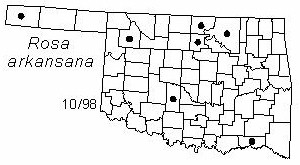Shrub with erect stems to 1.5 ft (45 cm) tall. Twigs red-brown with many straight spines and bristles. Leaves alternate, pinnately compound, 5-9 leaflets; leaflets elliptic, 1.6-6.4 cm (0.6-2.5) inches in length; glabrous, lustrous above, soft pubescent beneath; acute at base and apex; margins coarsely toothed; petiole glabrous or somewhat pubescent; stipules adnate, 1-2.5 cm (0.4-1 in) in length, margins entire; rachis glabrous or somewhat pubescent. Inflorescence a corymb, peduncles glabrous, flowers 2-4, 2.5-5 cm (1-2 in) in diameter; sepals 5, lanceolate, 1-1.2 cm (3/8-5/8 in) long; petals 5, white, obcordate; styles not exserted, but persistent; stamens numerous; flowers appear from May to August. Fruit a hip, 12-15 mm (1/2-3/5 in) diameter, subglobose to ellipsoid, sepals ascending, red; nutlets flattened on one side, light tan, tuft of hairs at the base; fruits mature late August.
Distribution: Oklahoma, Texas, and New Mexico, north to Colorado, east to Kansas and Minnesota.
Habitat: prairies, woodland margin and disturbed areas.
Comments: Rosa is the classical name for roses; arkansana refers to the Arkansas River at Canon City, Colorado, where the plant was first collected. Some of the collections in Oklahoma may be escapes from cultivation.
Horticulture: A hardy native rose, but stems may die-back following a freeze. Propagation is rather difficult.
Food uses: rose hips are an excellent source of vitamin C (60 times the concentration of lemons). Native Americans had several uses for wild prairie rose. Fruits were eaten raw or made into jellies, young spring shoots were cooked, young leaves and stems were prepared as tea. For many tribes, rose hips were an emergency food.
Medicinal uses: The Omahas steeped wild prairie rose hips and roots to treat inflammation of the eye. The Pawnees collected leaf galls which were crushed and applied to burns.
NWI status: none
Distribution in Oklahoma: 
BACK
NEXT
RETURN TO INDEX
Last update: 9/17/99
 Go to Oklahoma Biological Survey Home Page
Go to Oklahoma Biological Survey Home Page
 Disclaimer
Disclaimer